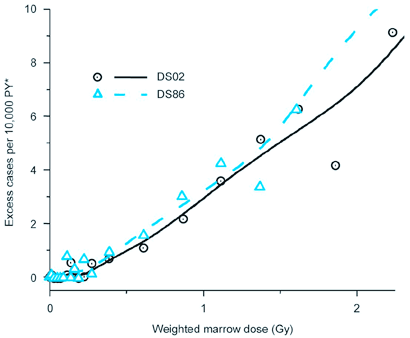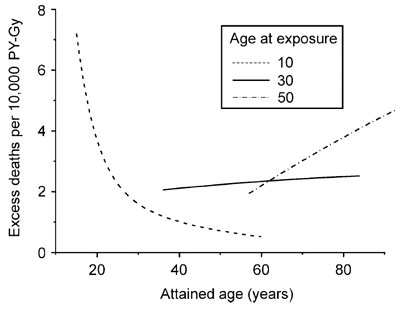Leukemia Risks among Atomic-bomb Survivors
Excess leukemia was the earliest delayed effect of radiation exposure seen in A-bomb survivors. Japanese physician Takuso Yamawaki in Hiroshima first noted an increase of leukemia cases in his clinical practice in the late 1940s. This led to the establishment of a registry of leukemia and related disorders and to the initial reports on elevated leukemia risks published in the early 1950s.
Risks for radiation-induced leukemia differ in two major respects from those for most solid cancers. First, radiation causes a larger percent increase in leukemia rates (but a smaller number of cases since leukemia is relatively rare, even in heavily exposed survivors), and second, the increase appears sooner after exposure, especially in children. The excess leukemias began appearing about two years after radiation exposure, and the excess peaked at about 6-8 years after exposure. Today, little if any excess of leukemia is occurring.
Because the Life Span Study(LSS) cohort was based on the 1950 national census, quantitative descriptions of leukemia risks in A-bomb survivors have been based on cases diagnosed from that year on. As of the year 2000, there were 204 leukemia deaths among 49,204 LSS survivors with a bone marrow dose of at least 0.005 Gy, an excess of 94 cases (46%) attributable to A-bomb radiation (Table). In contrast to dose-response patterns for other cancers, that for leukemia appears to be nonlinear; low doses may be less effective than would be predicted by a simple linear dose response. Even for doses in the 0.2 to 0.5 Gy range, however, risk is elevated (Figure 1).
Table. Observed and estimated excess number of leukemia deaths in LSS population, 1950-2000
|
||||||||||||||||||||||||||||||||||||
|
||||||||||||||||||||||||||||||||||||

*PY = person-years: in this case the number of excess leukemia cases per 10,000 persons per year
Figure 1. DS02 and DS86 non-parametric dose response of leukemia, 1950-2000. Shown is the sex-averaged risk in 1970 for exposure ages 20-39.
Leukemia risk among LSS survivors has been increased only for acute and chronic myelocytic leukemias and for acute lymphocytic leukemia. No evidence of increased risk is seen for adult T-cell leukemia (endemic in Nagasaki but virtually non-existent in Hiroshima) or for chronic lymphocytic leukemia, which, in marked contrast to western countries, is extremely rare in Japan. As in solid cancer risks, the leukemia risk also largely depends on the age at exposure (Figure 2). The different age effect involves different types of leukemias; acute lymphoblastic leukemia is more common among young people whereas chronic myelogenous leukemia and acute myelogenous leukemia are more common among elderly people.

Figure 2. Effects of age at exposure and attained age on the excess deaths from all types of leukemia (1 Gy exposure)
Because leukemia is a rare disease, the absolute number of leukemia cases among A-bomb survivors is relatively small even though the relative risk is high. Leukemia accounts for only about 3% of all cancer deaths and fewer than 1% of all deaths, although it presently constitutes about 16% of all excess LSS cancer deaths from radiation exposure. In an unexposed Japanese population, the lifetime risk of leukemia is about seven cases per 1,000 people. For typical survivors in the LSS, who received 0.005 Gy or greater (a mean dose of about 0.2 Gy), the lifetime leukemia risk increases to about 10 cases per 1,000 (or the relative risk is nearly 1.5).

